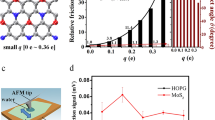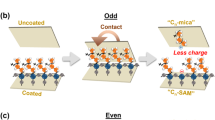Abstract
ELECTRICAL charge separation following contact between two materials (contact electrification or the triboelectric effect) is well known to occur between different materials as a consequence of their different electronic structures1,2. Here we show that the phenomenon occurs between two surfaces of the same material if one is coated with a single chemisorbed monolayer. We use the surface force apparatus3 to study contact electrification4 and adhesion between two silica surfaces, one coated with an amino-silane. The presence of this monolayer results in significantly enhanced adhesion between the surfaces, owing to electrostatic attraction following contact electrification, in accord with Derjaguin's electrostatic theory of adhesion5. At the same time, the observed increase in adhesion is consistent with Fowkes' acid–base model6 (in which acid–base interactions between surface groups are considered to be the predominant factor determining adhesion), as the monolayer converts the originally acidic silica surface to a basic (amine-terminated) one. These observations demonstrate a link between acid–base interactions and contact electrification.
Similar content being viewed by others
References
Harper, W. R. Contact and Frictional Electrification (Oxford Univ. Press, 1967).
Lowell, J. & Rose-Innes, A. C. Adv. Phys. 29, 947–1023 (1980).
Israelachvili, J. N. & Adams, G. E. J. chem. Soc., Faraday Trans. 1 74, 975–1001 (1978).
Smith, D. T. J. Electrostat. 26, 291–308 (1991).
Derjaguin, B. V., Krotova, N. A. & Smilga, V. P. Adhesion of Solids (Consultants Bureau, New York, 1978).
Fowkes, F. M. J. Adhesion Sci. Technol. 1, 7–27 (1987).
Horn, R. G., Smith, D. T. & Haller, W. Chem. Phys. Lett. 162, 404–408 (1989).
Grabbe, A. Langmuir 9, 797–801 (1993).
Horn, R. G. & Smith, D. T. Science 256, 362–364 (1992).
Mittal, K. L. & Anderson, H. R. (eds) Acid-Base Interactions: Relevance to Adhesion Science and Technology (VSP, Utrecht, 1991).
Papirer, E. & Balard, H. J. Adhesion Sci. Technol. 4, 357–371 (1990).
Lee, L. H. (ed.) Fundamentals of Adhesion Ch. 1 & 12 (Plenum, New York, 1990).
Fowkes, F. M. J. Adhesion Sci. Technol. 4, 669–691 (1990).
Author information
Authors and Affiliations
Rights and permissions
About this article
Cite this article
Horn, R., Smith, D. & Grabbe, A. Contact electrification induced by monolayer modification of a surface and relation to acid–base interactions. Nature 366, 442–443 (1993). https://doi.org/10.1038/366442a0
Received:
Accepted:
Issue Date:
DOI: https://doi.org/10.1038/366442a0
- Springer Nature Limited
This article is cited by
-
Contact Electrification Spectrum for Performance Enhancement Mechanism Investigation of Triboelectric Nanogenerators based on Silicone Elastomers with Different Surface Microstructures
Chinese Journal of Polymer Science (2023)
-
Modeling and optimization of a spherical triboelectric generator
Nano Research (2023)
-
Harvesting of flow current through implanted hydrophobic PTFE surface within silicone-pipe as liquid nanogenerator
Scientific Reports (2022)
-
Design of effective self-powered SnS2/halide perovskite photo-detection system based on triboelectric nanogenerator by regarding circuit impedance
Scientific Reports (2022)
-
Charge mosaics on contact-electrified dielectrics result from polarity-inverting discharges
Nature Physics (2022)





